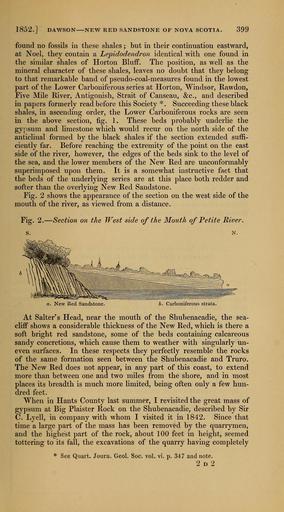MAKE A MEME
View Large Image

| View Original: | The_Quarterly_journal_of_the_Geological_Society_of_London_(12684836304).jpg (1773x3200) | |||
| Download: | Original | Medium | Small | Thumb |
| Courtesy of: | commons.wikimedia.org | More Like This | ||
| Keywords: The Quarterly journal of the Geological Society of London (12684836304).jpg 1852 DAWSON NEW RED SANDSTONE OF NOVA SCOTIA 399 <br> found no fossils in these shales ; but in their continuation eastward <br> at Noel they contain a Lepidodendron identical with one found in <br> the similar shales of Horton Bluff The position as well as the <br> mineral character of these shales leaves no doubt that they belong <br> to that remarkable band of pseudo-coal-measures found in the lowest <br> part of the Lower Carboniferous series at Horton Windsor Rawdon <br> Five Mile River Antigonish Strait of Canseau c and described <br> in papers formerly read before this Society Succeeding these black <br> shales in ascending order the Lower Carboniferous rocks are seen <br> in the above section fig 1 These beds probably underlie the <br> gypsum and limestone which would recur on the north side of the <br> anticlinal formed by the black shales if the section extended suffi- <br> ciently far Before reaching the extremity of the point on the east <br> side of the river however the edges of the beds sink to the level of <br> the sea and the lower members of the New Red are unconformably <br> superimposed upon them It is a somewhat instructive fact that <br> the beds of the underlying series are at this place both redder and <br> softer than the overlying New Red Sandstone <br> Fig 2 shows the appearance of the section on the west side of the <br> mouth of the river as viewed from a distance <br> Fig 2 Section on the West side of the Mouth of Petite River <br> a New Red Sandstone b Carboniferous strata <br> At Salter's Head near the mouth of the Shubenacadie the sea- <br> cUff shows a considerable thickness of the New Red which is there a <br> soft bright red sandstone some of the beds containing calcareous <br> sandy concretions which cause them to weather with singularly un- <br> even surfaces In these respects they perfectly resemble the rocks <br> of the same formation seen between the Shubenacadie and Truro <br> The New Red does not appear in any part of this coast to extend <br> more than between one and two miles from the shore and in most <br> places its breadth is much more limited being often only a ies hun- <br> dred feet <br> When in Hants County last summer I revisited the great mass of <br> gypsum at Big Plaister Rock on the Shubenacadie described by Sir <br> C Lyell in company with whom I visited it in 1842 Since that <br> time a large part of the mass has been removed by the quarrymen <br> and the highest part of the rock about 100 feet in height seemed <br> tottering to its fall the excavations of the quarry having completely <br> See Quart Journ Geol Soc vol vi p 347 and note <br> 2 D 2 35461469 109911 51125 Page 399 Text v 8 http //www biodiversitylibrary org/page/35461469 1852 Geological Society of London NameFound Lepidodendron NameConfirmed Lepidodendron EOLID 13132167 NameBankID 4921583 Biodiversity Heritage Library The Quarterly journal of the Geological Society of London v 8 1852 Geology Periodicals Smithsonian Libraries bhl page 35461469 dc identifier http //biodiversitylibrary org/page/35461469 smithsonian libraries Information field Flickr posted date ISOdate 2014-02-21 Check categories 2015 August 26 CC-BY-2 0 BioDivLibrary https //flickr com/photos/61021753 N02/12684836304 2015-08-26 20 55 13 cc-by-2 0 PD-old-70-1923 The Quarterly journal of the Geological Society of London 1852 Photos uploaded from Flickr by FĂŚ using a script | ||||